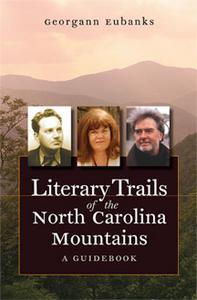

RALEIGH, N.C. -- The North Carolina Arts Council announces the debut of a guide that connects the lives and work of 170 of North Carolina's visiting and native writers with destinations across the 25 counties of the mountain region.
The guide has two formats, web and print. The web version, www.ncliterarytrails.org, was launched Sept. 28, 2007. UNC Press released the print version, Literary Trails of the North Carolina Mountains: A Guidebook, on Oct. 28.
The North Carolina Arts Council commissioned Georgann Eubanks to research and write the guide to showcase the array of writers associated with the western part of the state, encouraging readers to explore the landmarks that inspired many of the state's writers.
"This guide provides North Carolina residents and visitors with a wonderful catalog of the literary heritage we've been proud of for so long," said Mary B. Regan, executive director of the North Carolina Arts Council. "The writing is informative and entertaining, giving readers a chance to see the North Carolina mountains through the eyes of our literary artists."
The guide offers a glimpse into North Carolina literary history, from the William Bartram Trail followed by Inman, the protagonist of Charles Frazier's novel Cold Mountain, to the little town of Celo, where novelist Anne Tyler spent part of her childhood and started writing stories. Travelers can stay at the Toe River Lodge, in Plumtree, where the film version of John Ehle's novel, "The Winter People," starring Kurt Russell and Kelly McGillis, was shot. Travelers can also spend a night at the Nu-Wray Inn in Burnsville, known for its country cooking, where both Mark Twain and Elvis are reported to have stayed. A stop at Sonny's Grill on Main Street in Blowing Rock affords a chance to try fried liver mush, favored by one of Father Tim's parishioners in Jan Karon's "Mitford" series of novels.
The guide comprises 18 half-day and one-day tour itineraries which take travelers through the landscapes of Sequoyah, Thomas Wolfe, Kathryn Stripling Byer, Kay Hooper, Robert Morgan, and Wilma Dykeman, among others. Thirty maps, driving directions, and 103 color illustrations make the itineraries easy to follow.
The literary trail guide is part of a larger arts tourism program initiated some years ago by the state arts council. The Arts Council has published two other books in conjunction with UNC Press, one on music in the Blue Ridge Mountains and one on Cherokee heritage. As part of the Blue Ridge Heritage Initiative, the North Carolina Arts Council received the first Preserve America Presidential Award for Heritage Tourism in 2004.
? "Blue Ridge Music Trails: Finding a Place in the Circle," written by Fred C. Fussell, is a comprehensive traveler's guide to finding and enjoying old-time and bluegrass music and dance in the mountain communities. With more than 160 venues featured on 25 miles of Blue Ridge Parkway, readers can find jam sessions, concerts and street festivals that explore traditional forms of music and dance.
? "Cherokee Heritage Trails Guidebook," written by Barbara R. Duncan and Brett H. Riggs, takes a look at the southern mountain region of western North Carolina, eastern Tennessee and northern Georgia, documenting the Cherokee heritage rooted in sacred places, community ties, storytelling, folk arts and centuries of history.
Documenting the literary traditions and writers of western North Carolina, Literary Trails of the North Carolina Mountains holds up yet another lens through which to view the state's cultural landscape.
"North Carolina is a stimulating environment for writers," said Debbie McGill, Literature Director for the North Carolina Arts Council. "Inspired by our geographic diversity, encouraged by an attitude of welcome and generosity in our literary community, and supported by the services of such literary organizations as the North Carolina Writers Network, writers in all genres flourish here."
The guide's web version, found at www.ncliterarytrails.org, supports the book and will keep it up to date. It includes excerpts from the print version, a calendar of events and links to festivals, bookstores, historic sites, and other travel options. Perhaps most importantly, the online guide links visitors to resources -- writers' personal web sites, libraries, bookstores, and publishers -- that supplement the literary works that are the guide's real subject and mission.
Literary Trails of the North Carolina Mountains was written by Georgann Eubanks and funded by the North Carolina Arts Council and the University of North Carolina Press. A writer and consultant with more than 25 years of experience in the nonprofit sector, particularly in higher education and the arts, Eubanks has published short stories, poems, reviews and profiles in many magazines and journals including "Oxford American," "Bellingham Review," "Southern Review," "Duke Magazine," "Boston Globe Sunday Magazine" and "North American Review." She is a North Carolina Arts Council Writers Fellowship recipient, winner of a regional Emmy, former chair of the North Carolina Humanities Council and former president of Arts North Carolina, the industry's statewide advocacy and service organization.
"This book is full of examples of how creative writers help us know ourselves, our cultures, and our collective history," said Eubanks. "I hope the guidebook will lead readers back to the source -- to the poems, short stories, novels and plays that are surveyed and excerpted here."
To order a copy of Literary Trails of the North Carolina Mountains: A Guidebook, visit UNC Press at www.uncpress.unc.edu. To access the online guide, visit www.ncliterarytrails.org.